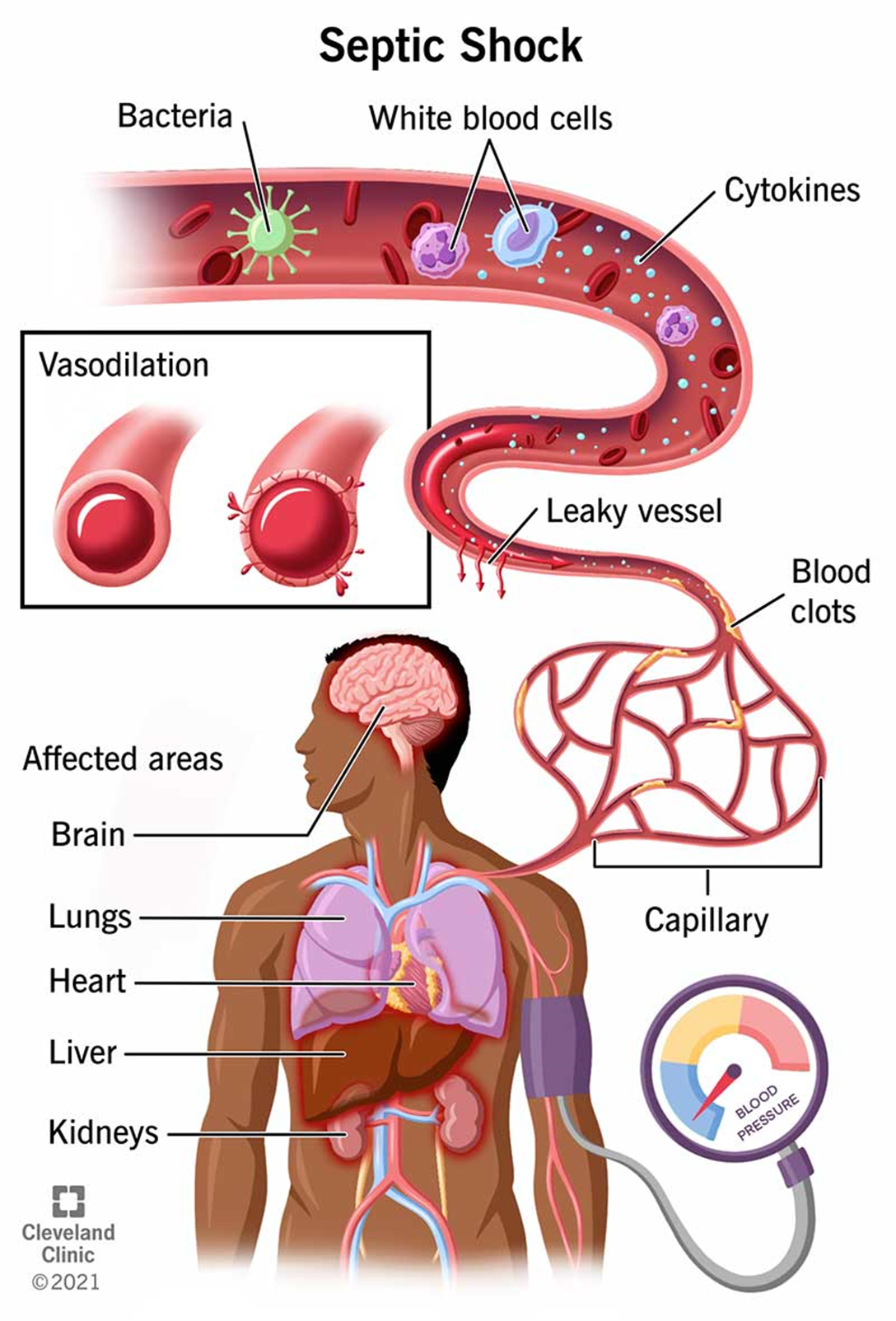A nurse is caring for an adolescent who has been admitted to the PICU with a diagnosis of septic shock. The nurse notes the following :
When planning care for this client, the nurse should anticipate a provider's prescription for which of the following?
Broad-spectrum antibiotics and fluid boluses
Antipyretics and oxygen therapy
Vasopressors and blood transfusions
Corticosteroids and antihistamines
The Correct Answer is A
Choice A reason: Broad-spectrum antibiotics are indicated for septic shock caused by bacterial infection, as they can target a wide range of pathogens and prevent further sepsis. Fluid boluses are also essential to restore the intravascular volume and improve tissue perfusion and oxygenation.

Choice B reason: Antipyretics and oxygen therapy are not sufficient to treat septic shock, as they do not address the underlying infection or the hypovolemia. Antipyretics may lower the temperature, but they do not eliminate the bacteria. Oxygen therapy may improve the pulse oximeter reading, but it does not correct the hypoperfusion.
Choice C reason: Vasopressors and blood transfusions are not the first-line treatments for septic shock, as they may have adverse effects on the cardiovascular system and the coagulation cascade. Vasopressors may increase the blood pressure, but they may also cause vasoconstriction and reduce the blood flow to vital organs. Blood transfusions may increase the hemoglobin level, but they may also increase the risk of fluid overload, hemolysis, and transfusion reactions.
Choice D reason: Corticosteroids and antihistamines are not indicated for septic shock, as they do not have any proven benefits and may have harmful effects on the immune system and the inflammatory response. Corticosteroids may suppress the adrenal function and increase the risk of infection. Antihistamines may cause sedation and dryness of the mucous membranes.
Nursing Test Bank
Naxlex Comprehensive Predictor Exams
Related Questions
Correct Answer is A
Explanation
Choice A reason: Encouraging the child to avoid sharing hats with other children is a preventive measure to reduce the risk of lice transmission. Lice are spread by direct contact with the hair or personal items of an infested person. Hats, combs, brushes, scarves, and pillows are some of the items that can harbor lice.
Choice B reason: The lice can survive for 2 weeks away from the host is a false statement. Lice cannot live longer than 24 to 48 hours without a human host. They need blood to survive and reproduce. Therefore, this information is not helpful for the parents to prevent or treat lice.
Choice C reason: Washing your child's hair daily will prevent lice is a false statement. Lice are not a sign of poor hygiene or cleanliness. They can affect anyone regardless of how often they wash their hair. In fact, lice may prefer clean hair because it is easier to attach to. Therefore, this information is not helpful for the parents to prevent or treat lice.
Choice D reason: Lice can jump from one child to another is a false statement. Lice cannot jump, fly, or hop. They can only crawl from one person to another. Therefore, this information is not helpful for the parents to prevent or treat lice.
Correct Answer is C
Explanation
Choice A reason: Continuing to monitor the client is not the best action, as it does not address the low urine output of the child. The child has a urine output of 20 mL/hr, which is below the expected range of 30 to 40 mL/hr for a 3-year-old child. Low urine output can indicate dehydration, kidney injury, or urinary tract obstruction, which require prompt intervention.
Choice B reason: Performing a bladder scan at the bedside is not the most appropriate action, as it is not the first-line diagnostic tool for low urine output. A bladder scan is a noninvasive ultrasound device that measures the amount of urine in the bladder. It can help detect urinary retention, which is the inability to empty the bladder completely. However, urinary retention is unlikely in a 3-year-old child, and a bladder scan may not be accurate or reliable in children.
Choice C reason: Providing oral rehydration fluids is the best action, as it can help restore the fluid and electrolyte balance of the child. Oral rehydration fluids are solutions that contain water, sugar, and salt in specific proportions that match the body's needs. They can prevent or treat dehydration, which is a common cause of low urine output in children. The nurse should offer the child oral rehydration fluids every 15 to 20 minutes, and monitor the urine output, vital signs, and hydration status.
Choice D reason: Notifying the provider is not the first action, as it is not the most urgent or effective intervention for low urine output. The nurse should notify the provider after providing oral rehydration fluids and assessing the child's response. The nurse should also report any signs or symptoms of dehydration, such as dry mucous membranes, sunken eyes, poor skin turgor, or lethargy. The provider may order further tests or treatments, such as blood tests, urine tests, or intravenous fluids.
Whether you are a student looking to ace your exams or a practicing nurse seeking to enhance your expertise , our nursing education contents will empower you with the confidence and competence to make a difference in the lives of patients and become a respected leader in the healthcare field.
Visit Naxlex, invest in your future and unlock endless possibilities with our unparalleled nursing education contents today
Report Wrong Answer on the Current Question
Do you disagree with the answer? If yes, what is your expected answer? Explain.
Kindly be descriptive with the issue you are facing.
